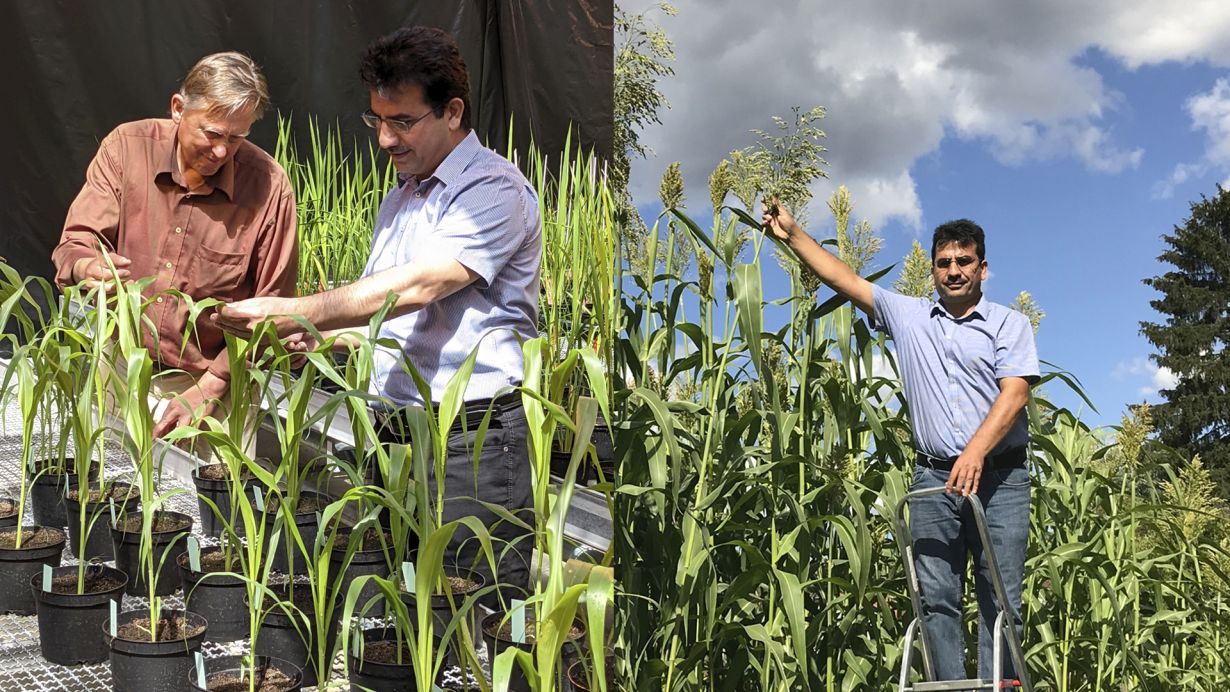Sweet sorghum can be used to produce biogas, biofuels, and novel polymers. In addition, it can help replace phosphate fertilizers. A new sweet sorghum variety developed at Karlsruhe Institute of Technology (KIT) accumulates particularly high amounts of sugar and thrives under local conditions. As the scientists reported in the Industrial Crops & Products journal, sugar transport and sugar accumulation are related to the structure of the plants’ vessels. This was the result of a comparison between sweet and grain sorghums. (DOI: 10.1016/j.indcrop.2021.113550)
As the world's population grows, the demand for food, raw materials, and energy is also on the rise. This increases the burden on the environment and the climate. One strategy to reduce greenhouse gas emissions is to grow so-called C4 crops. These carry out photosynthesis particularly efficiently, are therefore more effective in fixing carbon dioxide (CO2), and build up more biomass than other plants. Usually, they are native to sunny and warm places. One of the C4 plants is sorghum, also known as great millet, a species of the sorghum genus in the sweet grass family. The varieties that are particularly rich in sugar are called sweet sorghum (Sorghum bicolor L. Moench). Other varieties include grain sorghum used as animal feed. Sorghum can be grown on so-called marginal land, which is difficult to cultivate, so it does not compete with other food or forage crops.
A new sweet sorghum variety called KIT1 has been developed by Dr. Adnan Kanbar in the Molecular Cell Biology Division research group headed by Professor Peter Nick at the Botanical Institute of KIT. KIT1 accumulates particularly high amounts of sugar and thrives especially well under temperate climate conditions. It can be used both energetically, i.e. for the production of biogas and biofuels, and as a base material for the production of novel polymers. The estimated sugar yield per hectare is over 4.4 tons, which would correspond to almost 3,000 liters of bioethanol. In addition, the digestate produced during biogas production can be used for fertilizers to replace phosphate fertilizer, which will soon be in short supply.
The Plant Stem Anatomy is What Matters
Researchers at Nick’s laboratory, which is part of the Institute for Applied Biosciences, and their colleagues at the Institute for Technical Chemistry at KIT and at ARCUS Greencycling Technology in Ludwigsburg compared the KIT1 sweet sorghum and Razinieh grain sorghum varieties in order to investigate the different sugar accumulation behaviors in the plant stem. For the study, published in the Industrial Crops & Products journal, the team looked at the stem anatomy. This includes the thickened areas (nodes) and the narrow areas or spaces between nodes (internodes), but also transcripts of important sucrose transporter genes as well as stress responses of plants to high salt concentrations in the soil. Sugar accumulation was highest in the central internodes in both genotypes. However, a relationship was found between sugar accumulation and the structure of the vessels that serve to transport water, solutes, and organic substances. The vessels are grouped into vascular bundles. These consist of the phloem (bast part) and the xylem (wood part). The phloem mainly transports sugars and amino acids, while the xylem’s primary function is to transport water and inorganic salts; in addition, the xylem has a supporting function. The study revealed that in KIT1 and five other sweet sorghum varieties, the phloem cross-sectional area in the stem is much larger than the xylem cross-sectional area – the difference is much more pronounced than in the Razinieh grain sorghum variety. “Our study is the first one to look at the relationship between the structure of the vascular bundles and sugar accumulation in the stem,” Nick says.
Sweet Sorghum Copes Better with Salinity Stress
As the study further revealed, salinity stress led to higher sugar accumulation in KIT1 than in Razinieh. The expression of sucrose transporter genes was higher in KIT1 leaves under normal conditions, and increased significantly under salinity stress. “Besides anatomical factors, there also some molecular factors that might contribute to regulating sugar accumulation in the stem,” Kanbar explains. “In any case, KIT1 responds better to salinity stress.”
Original Publication
Adnan Kanbar, Ehsan Shakeri, Dema Alhajturki, Michael Riemann, Mirko Bunzel,
Marco Tomasi Morgano, Dieter Stapf, Peter Nick: Sweet versus grain sorghum: Differential sugar transport and accumulation are linked with vascular bundle architecture. Industrial Crops & Products, 2021. DOI: 10.1016/j.indcrop.2021.113550
Abstract at https://doi.org/10.1016/j.indcrop.2021.113550
In close partnership with society, KIT develops solutions for urgent challenges – from climate change, energy transition and sustainable use of natural resources to artificial intelligence, sovereignty and an aging population. As The University in the Helmholtz Association, KIT unites scientific excellence from insight to application-driven research under one roof – and is thus in a unique position to drive this transformation. As a University of Excellence, KIT offers its more than 10,000 employees and 22,800 students outstanding opportunities to shape a sustainable and resilient future. KIT – Science for Impact.

